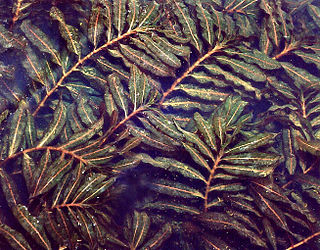
Potamogeton is a genus of aquatic, mostly freshwater, plants of the family Potamogetonaceae. Most are known by the common name pondweed, although many unrelated plants may be called pondweed, such as Canadian pondweed. The genus name means "river neighbor", originating from the Greek potamos (river) and geiton (neighbor).
This article gives an overview of the aquatic communities in the British National Vegetation Classification system.

Luronium natans is a species of aquatic plant commonly known as the floating water-plantain. It is the only recognized species in the genus Luronium, native to western and central Europe, from Spain to Britain to Norway east to Ukraine.

Potamogeton crispus, the curled pondweed or curly-leaf pondweed, is a species of aquatic plant native to Eurasia but an introduced species and often a noxious weed in North America.

Potamogeton natans, commonly known as broad-leaved pondweed, floating pondweed, or floating-leaf pondweed, is an aquatic species in the genus Potamogeton native to quiet or slow-flowing freshwater habitats throughout the Holarctic Kingdom.

Potamogeton perfoliatus is a perennial aquatic plant in the family Potamogetonaceae occurring in both standing and flowing freshwater habitats. It is widely distributed globally, occurring in all continents except South America and Antarctica.

Potamogeton praelongus, commonly known as whitestem pondweed in North America and Long-stalked Pondweed in Britain, is a large, perennial aquatic plant in the family Potamogetonaceae. It is widely distributed in lakes and rivers in the northern hemisphere, but is sensitive to poor water quality.

Potamogeton coloratus, the fen pondweed, is an aquatic plant in the genus Potamogeton. It is found in shallow peaty calcareous lakes, ponds and ditches, commonly associated with lowland fens.

Potamogeton lucens, or shining pondweed, is an aquatic perennial plant native to Eurasia and North Africa. It grows in relatively deep, still or slow-flowing, calcareous freshwater habitats.

Potamogeton alpinus is a species of perennial aquatic plant known by the common names alpine pondweed and red pondweed. It is widespread in the northern hemisphere in both rivers and lakes with good water quality.

Potamogeton epihydrus is a perennial aquatic plant known by the common names ribbonleaf pondweed and Nuttall's pondweed, and American pondweed in the United Kingdom. It is native to much of North America, where it grows in water bodies such as ponds, lakes, ditches, and slow-moving streams.

Potamogeton gramineus is a species of aquatic plant known by the common name various-leaved pondweed, variableleaf pondweed, grass-leaved pondweed or grassy pondweed, native to the northern hemisphere where it grows in shallow, clean water.

Potamogeton pusillus is a species of aquatic plant known by the common names small pondweed, lesser pondweed or least pondweed. It occurs in standing and slow-flowing freshwater habitats throughout the Northern Hemisphere.

Potamogeton compressus is a species of aquatic plant known by the common names grass-wrack pondweed, flatstem pondweed and eel-grass pondweed.

Potamogeton obtusifolius, known as blunt-leaved pondweed, is an aquatic plant in the genus Potamogeton. It grows mainly in mesotrophic to eutrophic lakes, ponds and ditches, rarely in brackish water. It occurs primarily in Central Europe, the British Isles, Fennoscandia and eastern North America.

Potamogeton berchtoldii, common name small pondweed is an aquatic plant.

Potamogeton acutifolius is a European species of aquatic plant in the family Potamogetonaceae, known by the common name sharp-leaved pondweed. It is threatened and declining in at least part of its range.
Potamogeton × griffithii is a hybrid pondweed between Potamogeton alpinus and Potamogeton praelongus. It occurs in oligotrophic, moderate alkalinity lakes.

Potamogeton trichoides is a species of aquatic plant known by the common name hairlike pondweed, native to Europe and western Asia where it grows in calcareous, usually nutrient-rich standing or slow-flowing water.

Potamogeton friesii, known as flat-stalked pondweed, or Fries' pondweed, is an aquatic plant in the genus Potamogeton. It grows mainly in mesotrophic to eutrophic rivers, lakes, ponds and ditches, rarely in brackish water. It occurs in North America, Europe, western Asia and a few scattered locations elsewhere in Asia.




















